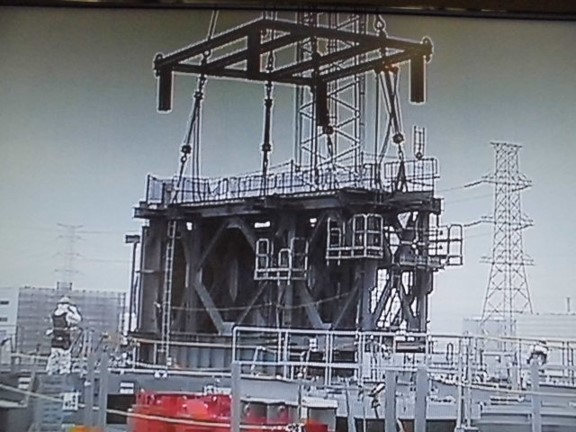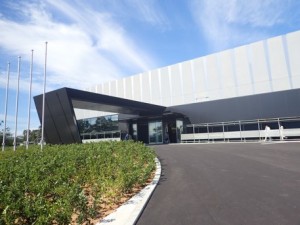Six Years Later, Many to Go
Along a freshly paved drive, a gleaming new administration building awaits hundreds of workers who soon will busily occupy its many office spaces. One could imagine this scene being anywhere - but it is at the Fukushima Daiichi nuclear power plant, where six years ago a serious nuclear accident occurred. This sight seems out of place with others found in the area of this once practically devastated site, and it is. But it is evidence of steady, continued progress during these six years.
Looking for Answers
The last quarter of 2016 and the beginning of 2017 have seen rapid progress made in answering the most burning question about the present condition of the nuclear plants, which is this: What are the condition and location of the damaged and melted fuel in the three units which suffered accidents? This determination is absolutely essential in order for TEPCO to plan out how to remove these materials and ultimately dismantle and remove the highly contaminated reactor buildings. Progress has been steady, sometimes not as planned, and at times, confusing.
Muon testing, which is kind of like a giant X-ray, revealed that earlier assumptions seemed correct, at least in two cases - namely, that the fuel all melted out of Unit 1's reactor vessel and that most of it is still inside Unit 2's reactor vessel. In recent months TEPCO has deployed an array of camera probes and robots to enter the containment vessel of Unit 2 to determine conditions and location of the fuel. Unit 1 will follow soon. Very high radiation - not unexpected, given the circumstances - was encountered inside Unit 2's containment, but there was not much solid information obtained as to the exact location of any melted fuel or any penetrations of the reactor vessel. A number of control rod drives were seen to be in original position, meaning there was not gross failure of the reactor vessel bottom head, but a large area of grating below these is missing and other areas deformed. It is surmised that this could be due to heat, or due to impact of melted fuel. The problem remains that none of the methods of examining the area below the reactor have lasted operationally long enough to give a solid answer as to the location of melted fuel in the containment. That being said, through these attempts, TEPCO has gained invaluable experience for use in future examinations, and in all probability, new robots too.
The high radiation levels encountered by the probes and robots made a sensation in the press, at least for a week or two. However, the radiation levels being encountered in the containment vessels are not out of the range of credibility or, for that matter, realistic expectation. What matters is that no effects off-site have changed, even though the suspected high levels near the damaged reactors have been confirmed.
Getting Ready to Move

A steel frame for mounting the Unit 3 fuel handling machine is prepared. Photo credit TEPCO Holdings Inc.
Quite well-known are the early questions surrounding the spent fuel pool at Fukushima Daiichi Unit 4, which turned out to be unwarranted as the fuel was removed intact from that pool years ago. However, spent fuel still remains in the pools at Units 1, 2 and 3. The groundwork is being laid to remove it. At Unit 1, the large enclosure constructed around the whole reactor building to contain radioactive emissions has been removed and the building roof (formerly the refueling floor) sprayed with an agent to prevent creation of dust - a sealant. At Unit 2, preparations are underway to saw off the upper part of the building down to the refueling floor. At Unit 3, a new refueling enclosure is already under construction and being tested at a nearby site. The enclosure will contain the spent fuel as it's removed, as well as support the crane to be used for performing this task. This is necessary to add, as all original equipment was destroyed in the accident. Shielding deck material has been added to the roof of the unit to limit the radiation exposure to workers as the work is performed. While it will be 30 or more years before the melted core material is removed from Units 1, 2 and 3, the spent fuel will be removed much sooner (2017 through 2020) and transferred to the site's common fuel pool area.
Work Conditions Have Improved
On the work site, the area that requires full anti-contamination clothing and respirators has been reduced to just the immediate space of nuclear units 1 to 4, and a couple of other disjointed areas on-site. This differs from the earlier times when this gear was required everywhere on site. Furthermore, improved working accommodations and a hot-meal kitchen have been added on-site. The food prepared at the work-site is entirely sourced from Fukushima Prefecture. TEPCO has reported that morale has improved.
Everywhere on the site, though, the appearance has changed from the early days in two ways. First, most of the tsunami and explosion-related debris is gone - shuttled away to storage sites off the north end of the power plant site. Secondly, TEPCO has paved over all exposed areas on the site, so now it resembles a moonscape. Everywhere you look, you will see that the ground is concrete-gray instead of brown earth and green grass and plants. This was necessary to do to halt spread of contamination, and to prevent, as much as possible, the moving of water down into the ground and then into the damaged nuclear plant buildings.
TEPCO has reported that all the stored water on-site, contained in many dozens of large tanks, has been treated to remove radionuclides. The early-style bolted or built-up tanks are being removed and are instead being replaced with leak-tight welded tanks. Efforts are underway (as this is written) to sample water in the Unit 1 turbine building basement, which has accumulated heavily since the accident, and then to pump it out. This is the first such effort to dewater a major building directly involved in the accident.
The challenges still ahead are many. How will the damaged cores, and melted fuel not in the reactor vessels, ultimately be removed? What technologies will be needed to dismantle the reactor buildings?To assist with the development of what will be needed, TEPCO has included in its new TEPCO CUUSO open innovation platform section a special range for collaborative work in the field of decommissioning. Click here to see the CUUSO website.
Going Home, Starting Again
At the end of March, the evacuation orders for four towns affected by the quake, tsunami and nuclear accident will be lifted. According to Japan Today, in the oceanside town of Namie, not all of the residents will be coming back - specifically, many of the younger population. Since schools have not yet been restarted, it will not be ideal for young families. However, long time citizens and business owners are eager to restart the town's life, with somewhat of a "now or never" attitude, at least on the part of Namie town's mayor Tamotsu Baba, as described by Japan Today.
Part of Namie town will not be repopulated, as it's still off limits due to contamination and storage of contaminated material. But it is safe to say that the free return of citizens to a town just two and a half miles from the Fukushima Daiichi plant is a verifiable milestone in the recovery of the region.
The Next Year
Just as recently as March 9, 2017, TEPCO announced the latest technical investigation into conditions near one of the damaged reactors (see here). The plan reflects all the learning that TEPCO and its contractors have experienced to date when investigating the damaged units, and plans are in place to avoid pitfalls that halted earlier investigations. It's obvious that a steep learning curve is being surmounted by all involved as the concern presses toward the answers it needs to decommission the plant. There is hope that the technical problems will be overcome and that the knowledge required is gained.
Outside the plant there's also hope - hope among those who intend to return home. For those people, life may never again be what it was, but the feeling of being away from home, and from history and heritage will be eased.
 Will Davis is Communications Director and board member for the N/S Savannah Association, Inc. He is a consultant to the Global America Business Institute, a contributing author for Fuel Cycle Week, and he writes his own popular blog Atomic Power Review. Davis is also a consultant and writer for the American Nuclear Society, and serves on the ANS Communications Committee and on the Book Publishing Committee. He is a former U.S. Navy reactor operator and served on SSBN-641, USS Simon Bolivar.
Will Davis is Communications Director and board member for the N/S Savannah Association, Inc. He is a consultant to the Global America Business Institute, a contributing author for Fuel Cycle Week, and he writes his own popular blog Atomic Power Review. Davis is also a consultant and writer for the American Nuclear Society, and serves on the ANS Communications Committee and on the Book Publishing Committee. He is a former U.S. Navy reactor operator and served on SSBN-641, USS Simon Bolivar.


